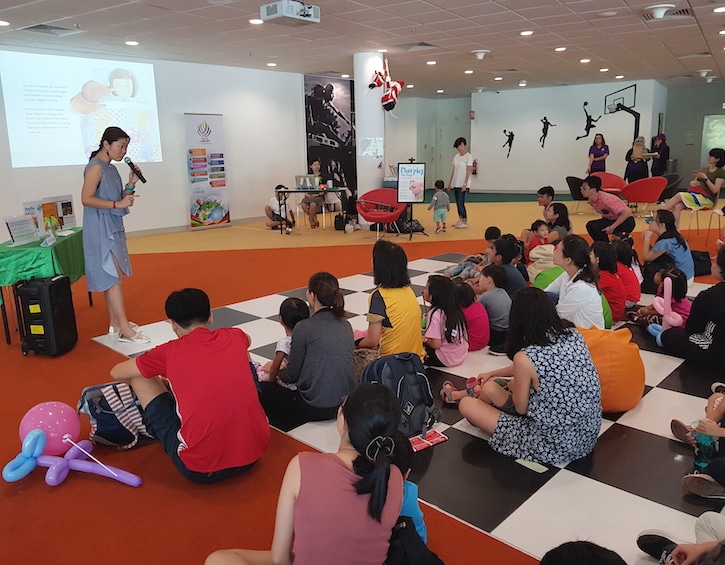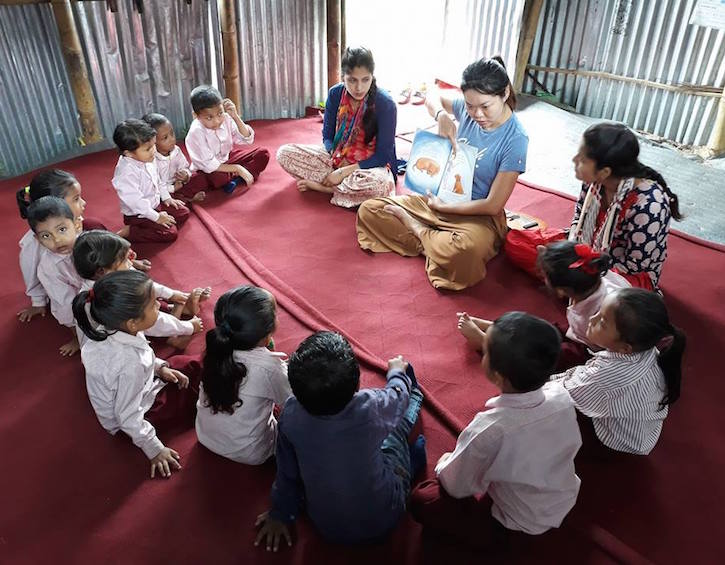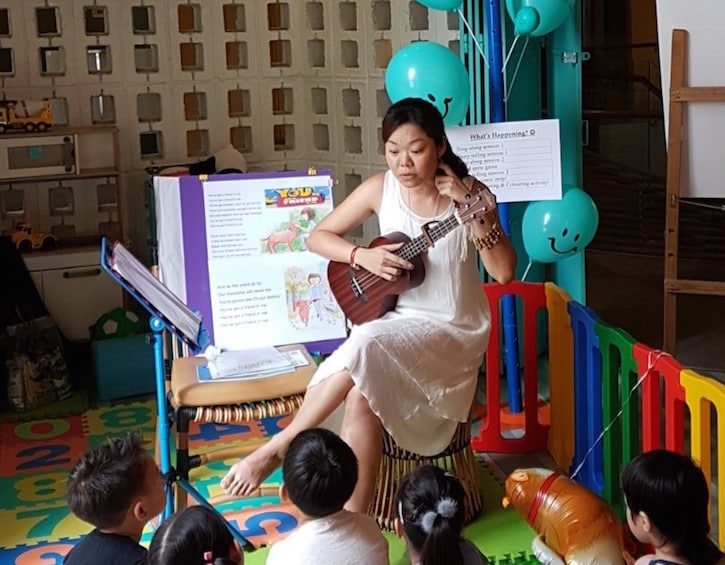
This Diabetes alert dog has something to teach your kids about self-worth so they, too, can shine
 Murphy, See How You Shine! A Story That Celebrates the Gifts within Us by Chen Wei Teng is a story of a blind dog, Murphy, who has low self-esteem and worries he is a burden on his owner, Candy, who has Type 1 Diabetes. Murphy, however, has a very unusual gift: he has been trained as a Diabetes alert dog who alerts Candy when her blood sugar level goes dangerously low.
Murphy, See How You Shine! A Story That Celebrates the Gifts within Us by Chen Wei Teng is a story of a blind dog, Murphy, who has low self-esteem and worries he is a burden on his owner, Candy, who has Type 1 Diabetes. Murphy, however, has a very unusual gift: he has been trained as a Diabetes alert dog who alerts Candy when her blood sugar level goes dangerously low.
When Murphy helps a young boy with Type 1 Diabetes, he soon realises that despite his own physical disability his gift can help others. We chatted with the author who self-published, Chen Wei Teng, formerly an educational therapist with the Dyslexia Association of Singapore and now a literacy coach at a vocational school in Singapore.
Read more: Skip the Selfies: The Psychological Effect of Social Media on Kids, and How Mamas Can Help
Why did you decide to write Murphy, See How You Shine!?
 The idea for the story took root 10 years ago when I was working as an educational therapist with the Dyslexia Association of Singapore (DAS). I was inspired by the ingenious minds of children with Dyslexia and other learning difficulties such as Attention Deficit Hyperactivity Disorder (ADHD) and Dyspraxia whom I worked with, and was touched by my students’ capacity to thrive despite their struggles to learn. But as with many dreams, I didn’t act on it and just kept the story in my computer.
The idea for the story took root 10 years ago when I was working as an educational therapist with the Dyslexia Association of Singapore (DAS). I was inspired by the ingenious minds of children with Dyslexia and other learning difficulties such as Attention Deficit Hyperactivity Disorder (ADHD) and Dyspraxia whom I worked with, and was touched by my students’ capacity to thrive despite their struggles to learn. But as with many dreams, I didn’t act on it and just kept the story in my computer.
The story took further shape with my experiences working with students in the present school that I am teaching at, NorthLight School. NorthLight School is a vocational school that takes in students who failed their PSLE (the compulsory exam that 12-year-old Singaporean children must take), where many of them struggle to cope with their learning difficulties. Some also struggle to make meaning for themselves, having come from challenging and disadvantaged family backgrounds. Unavoidably, many suffer from low self-esteem and see themselves as “failures” in life. Yet many long to be affirmed and recognised for who they are. This story is borne in a bid to celebrate the lives of the students whom I teach.
How do you encourage your students to be self-confident? Do you have any tips for mums to encourage self-esteem?
As an educator for the past 13 years working with students struggling with confidence issues, I came to realise that many of their psycho-social or emotional challenges stemmed from their difficulties in realising that they have precious gifts within themselves that they can use to better the lives of the people around them. Hence, I believe it is so important to help our children realise these gifts, which they can use to light up people’s lives — and that when they light up other people’s lives, they light up their own lives. That can go a long way in building up a child’s self-confidence.
It can come in the form of affirming and letting a child know specifically how his kind actions in helping a younger sibling with Maths questions are so helpful. Or even as simple as acknowledging that a child who often helps mummy with household chores really makes a difference in keeping the house neat. When praises are specific, they can be really life-affirming.
Read more: The Importance of Self-Confidence in Kids (and How to Boost Your Child’s)

Diabetes alert dogs are fascinating and we loved reading about these dogs who are trained to help Type 1 diabetics in this way. Are there any Diabetes alert dogs in Singapore and if so, did you work with them to understand their skills?
They were absolutely fascinating to me, too when I first got to learn about them! In fact through my research for my book, I came to realise how common they are in other countries, like the United States. In Singapore, though, it is a very new concept (we are more used to the idea of service dogs as servicing the blind community or therapy dogs, for instance). It is thanks to Ms Stella Chew that I got to know about them. I first chanced upon her story in The Straits Times last year and I was intrigued to learn how she tapped into the strengths of her dog, Butter, training it to be diabetic alert to help her overcome her health difficulties.
She then went one step further by helping other dog owners with Diabetes train their dogs, and encouraging them to pass on their knowledge. I reached out to her and got to know of the Type 1 diabetic community better (she is also the founder of Dogs and Diabetes Singapore). From my last research, there are four diabetic-alert dogs in Singapore.
Read more: Living with Type 1 Diabetes: A Mama’s Story of Her Pregnancy

Your book is designed to be Dyslexic-friendly – in what way?
My book uses a sans serif font (Century Gothic). A sans serif font is one with no tails at the end of the strokes, hence the letters have clearer visual shapes as there are no ticks/tails at the end of the strokes, making them more differentiated compared to serif font (eg. Times New Roman). Serif font can be harder to read for people with Dyslexia, as they have tails and other features that make the basic letter shapes look complicated.
In addition, some dyslexics may experience ‘visual crowding’ which makes it difficult for them to make sense of and recognize letters, especially when the letters are cluttered within each word. Reading can then become difficult as they have to put in a lot of effort to focus on letters within words, and words within lines. My book uses a bigger font size and the spacing between letters and between lines is also increased, which make reading easier for dyslexics as the page looks less cluttered and has more “room to breathe”.
In your experience are children with ADHD or Dyslexia able to be integrated into the education system and have support for national exams?
Children with ADHD or dyslexia fall in a spectrum. There are those who are able to be integrated well within the education system given some support (eg. having Allied Educators work with them, and receiving remediation and intervention from an early age). Having support during national exams (what we call “access arrangements”) do help as well in levelling the playing field for these students.
In other cases where ADHD and/or Dyslexia is more severe, they may struggle more significantly to cope within the education system. And if these children do not receive sufficient and timely intervention due to their family circumstances (eg if they come from families with lower socio-economic status who are unable to send their children for intervention), they are likely to continue to struggle to keep up as they get older.

We understand a portion of the proceeds from book sales will go to the school New Vision Academy in Nepal. Tell us about this school and was there a reason this school captivated you (rather than choosing to support a charity for disadvantaged families in Singapore)?
Murphy was borne out of a childhood dream of putting out a story that I really want to share, to the world. It could have remained just a dream, if not for the fact that New Vision Academy, a school located in the remote Saring village in Lamjung in Nepal, entered my life. I chanced upon this school when I was volunteering in Nepal last year; it takes in children of poor people from the lower castes who have little access to educational opportunities.
Life has an interesting way of presenting things upon you. The school’s belief that students from the lower castes should get quality education in order to break out of the poverty cycle called out to me and resonated with the work I do in Singapore (working with children and youths who come from disadvantaged families).
I was also very touched by the passion and drive of its principal, Shamser Thapa, who has since become a very dear friend, in wanting to improve the lot of his fellow Nepalese in the remote villages. Hence the school provided me the impetus to make my publishing dream a reality, so I in turn use it as a tool to help fundraise for the school which was in danger of closing. For that, I am very thankful! You can find out more about the school here.

What do you hope your book will achieve — for people with low self-esteem/your students, and for a wider Singaporean audience vis a vis the topic of Diabetes?
I hope my book will allow more people to understand the struggles experienced by children and teenagers who may have fallen out of the mainstream, and the emotional baggage they tend to carry around.
I also hope the book can be a tool to help children in their social-emotional learning. With adults reading the book with them, my wish is for the book to offer a platform to plant seeds of conversation and start a discussion about disabilities, learning difficulties, being different, and how to overcome obstacles by making meaning amidst life’s imperfections.
As Diabetes has recently been deemed a serious problem in Singapore, my wish is for this book to help generate awareness amongst readers, especially Type 1 Diabetes which may not be as commonly understood as compared to Type 2 Diabetes (which is the more common type of diabetes in Singapore). Hence, I was very glad to have the chance to work with Beta Change, an online group recently set up by the Diabetes community that advocates for living a full life. In their Global Postcard series, I was invited to share about my inspiration for the story of Murphy.
Thanks for taking the time to speak with us, Wei Teng!
Murphy, See How You Shine! A Story That Celebrates the Gifts within Us is available online, as an e-book and at all Kinokuniya outlets and retailing at $14.90 (+GST).






 View All
View All




 View All
View All









 View All
View All





